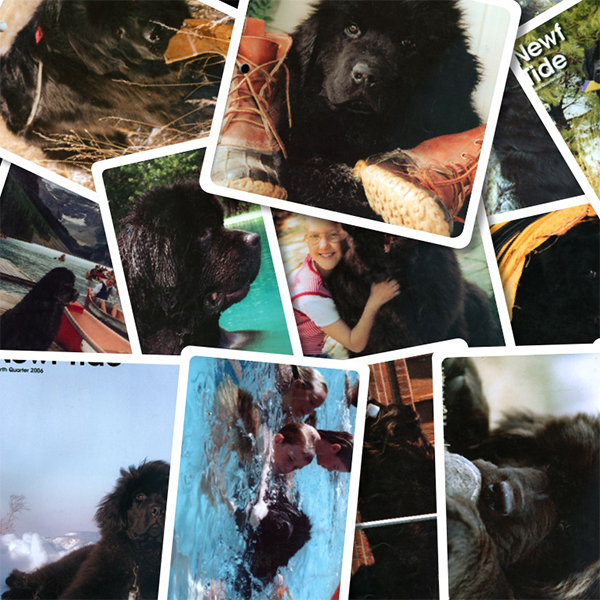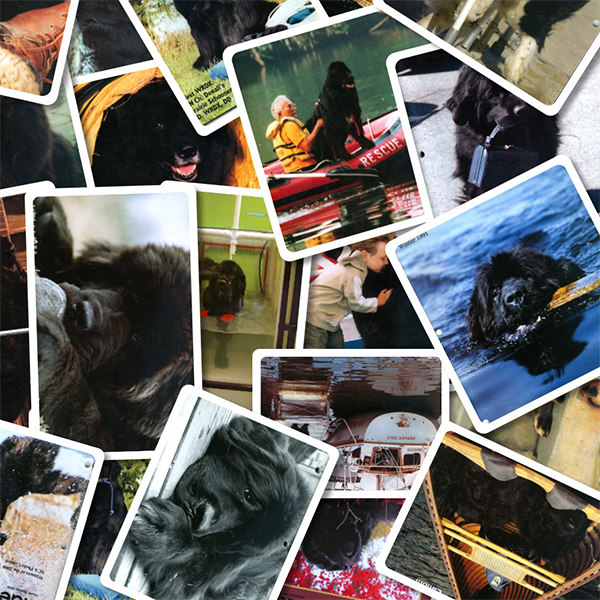by Roger Powell
What is the origin of our wonderful dogs? Are they the last survivors of Leif Erikson's ill-fated colony on Vinland? Are they members of a unique breed derived from black wolves in North America? Was the breed developed by the First Nation Peoples who lived on the island we now call Newfoundland? Information new since I last wrote on this topic 15 years ago, provides clues to the origin of dogs and to the origin of our breed, specifically. To relieve your curiosity, the answers to the questions are: We do not know. No. And No. Stay tuned, however, for details.
Recent analyses of DNA verify that dogs are domesticated wolves and are not derived from coyotes or jackals or any other known canid. Exactly which wolves were the forbearers of most dogs is not known presently; no population of wolves from which we have genetic data matches the predicted original genetic background for the ancestor of most domestic dogs. Dogs do appear, however, to have been domesticated twice, and a few breeds from Asia appear to have been interbred with wolves more recently than other breeds. Olsen's and Olsen's conclusion from 20-odd years ago that the Chinese wolf was the progenitor of domestic dogs found in North American before European settlement has not been supported by research on DNA. The exact wolf progenitor for most domestic dogs, including Newfoundlands, is not known.
Dogs first appear at archeological sites dated to some 14,000 years ago. DNA analyses indicate that dogs may have been domesticated thousands to tens-of-thousands of years before that time, but were not different enough from wolves to be identified as dogs. Dating of DNA changes projected beyond the limits of other data, however, is poor, so the date of first domestication for dogs is still known only very roughly. A few archeological sites older than 14,000 years have remains of wolves that appear associated with people; perhaps these wolves were actually dogs, having the important behavioral traits of dogs but no distinguishing physical traits.
Archeological research on the island of Newfoundland shows clearly that the First Nation peoples there had domestic dogs but that their dogs held no resemblance to our present day Newfs. Richard Tuck, who has done extensive archeological research in Newfoundland over many decades, stated unequivocally that the present breed can not be related, other than in a minor way, to the dogs owned by the native peoples before the arrival of European man.
Research done by Vila and his coworkers shows that domestic dogs appear to fall into 4 major groupings, according to their mitochondrial DNA (m-DNA). Mitochondria are organelles within cells that have their own small segments of DNA. The actual sequence of nucleic acids in the m-DNA for a dog can be identified and used to characterize that dog and to group it with other dogs of different breeds. The four groupings represent two acts of domestication, one act leading to one major grouping and the other leading to the other three, including the largest grouping. Newfoundlands land firmly in the largest grouping, along with such diverse breeds as Boxers, Kuvasok, Norfolk Terriers, and many others including a host of crossbreeds. Many breeds show evidence of having been crossed with other breeds, because more than one m-DNA sequence exists within these breeds. Too few data have been collected on Newfs to document such cross-breeding. Several of the breeds known to have been derived from Newfs, for example Labrador Retrievers, Golden Retrievers and Flat-coated Retrievers, show crossbreeding. Because Newfs are the parent breed for these other breeds, Newfs might not show any evidence of crossbreeding when more data become available. Present data do show clearly that the Newfoundland breed lands squarely within the genetic background of a large number of breeds and does not represent a unique act of domestication. Newfs are dogs, derived from other dogs, and not derived from wolves here in North America.
Newfs also show many classic characteristics of domestic dogs. Most domestic animals appear to differ from their parent, wild species predominantly through genetic changes in development, especially the timing of the development of certain traits. "Heterochrony" refers to evolutionary changes in rates of development, coming from "hetero," which means "different" in Greek, and from "achronos," which means time. Dogs in general and Newfies in particular have retained as adults many characteristics that are considered to be juvenile characteristics in wolves, such as floppy ears, the ability to form social bonds and a muzzle that appears relatively short. Retaining juvenile characters is a specific form of heterochrony called "Neotony." Newfs and other dogs, however, are not juvenile wolves; they are animals that differ from their evolutionary ancestors by having rates of development that differ for some characteristics, and some of the differences concern juvenile traits that never mature to the form found in the ancestor or that mature at late ages. Newfoundland dogs retain the characteristic of rapid growth to a later age than do most other breeds and wolves, and, thereby, also retain such related juvenile characteristics as large paws, floppy ears and short muzzle.
Some of the juvenile traits found in Newfies and other dogs may have been selected purposefully by people while others appear to have come along for the ride. Dmitry Belyaev initiated research on wild foxes some 40 years ago with the goal of understanding better the process of domestication. He bred his faxes selectively, breeding only for tameness, or the ability to get along with humans. His breeding could well have selected directly for delayed development of dominance and, hence, the retained ability to develop social bonds. Many other characteristics of domestic animals appeared in his foxes, however, for which he did not select at all, such as floppy ears, piebald coat pattern, a star on the forehead, curly tail, short tail and legs, and semi-annual estrous period. Apparently, the changes in development that led to tameness affected development of other traits indirectly, leading to a suite of characteristics found in dogs, horses, pigs and other domestic animals.
Different traits respond differently to selection for tameness. The eyes of all adult domestic dogs are nearly the same size, despite the huge differences in body size. Teeth, also, are relatively less changed in size among breeds than are total body sizes. These parts of a dog's body less susceptible to evolutionary change than total body size, coat color, and tameness.
All domestic animals, with the possible exception of cats (no further comment), are derived from animals that live in well developed social groups. Wolves live in packs, which are extended family groups, and young wolves stay in the packs of their birth for three years or so before dispersing to make or join another pack. Wolves are by far the most social, and most consistently social of canids. Other canids, coyotes, for example, and red faxes, sometimes form stable social groups but they do not do so across such broad ecological and geographical ranges as do wolves. Wild members of the genus Equus, the horses and zebras, all live in stable social groups their entire lives. The progenitor species of our domestic animals may be somewhat neotenic themselves, retaining some ability to maintain social bonds into adulthood. If so, the ancestral dogs and horses and pigs may have had the genetic foundation not just to form social groups but also to be able to vary rates of development conducive to domestication.
What, finally, do we know about our Newfs? We know that the breed developed since the settlement of North America, and Newfoundland, by European Man and that the breed did not exist on the island of Newfoundland before European settlement. We know that the breed is closely related to many other European breeds and lacks recent cross-breeding with wolves. And we know that the breed developed through selection for traits that are common among domesticated animals. Could the Newfoundland breed have developed through breeding of dogs brought to Newfoundland by Scandinavian colonists with local dogs used by the First Nation peoples? Maybe. No archeological evidence exists indicating that dogs on Newfoundland became larger after the Scandinavian colonization but the data are limited; lack of evidence is not negative evidence but it does indicate that the probability is low.
Your dog's major characteristics were probably selected by the hard-working people of Newfoundland during the 18th and early 19th centuries. By the late 19th century, our breed largely resembled the breed of today. Since then, the breed has developed the final characteristics that make your dog the perfect dog for you.
Give that perfect dog a hug from me.
References
Clutton-Brock, J. 1995. Origins of the dog: Domestication and early history. Pp 7-20. In: Serpell,J. (editor) 1995. The Domestic Dog: Its Evolution, Behaviour, and Interactions with People. Cambridge University Press, Cambridge.
Coppinger, R. & R. Schneider. 1995. Evolution of working dogs. Pp 21-47. In: Serpell, J. (editor) 1995. The Domestic Dog: Its Evolution, Behaviour, and Interactions with People. Cambridge University Press, Cambridge.
Morell, V 1997. The origin of dogs: Running with the wolves. Science 276: 1647-1648.
Olsen, S.J. &J. W. Olsen. 1977. The Chinese wolf, ancestor of new world dogs. Science 197: 533-535.
Powell, R. A. 1984. Some notes on the origin of the Newfoundland dog. NewfTide 15(3): 44-45.
Schwartz, M. 1997. A History of Dogs in the EarlyAmericas. Yale University Press, New Haven, Connecticut.
Serpell, J. (editor) 1995. The Domestic Dog: Its Evolution, Behaviour, and Interactions with People. Cambridge University Press, Cambridge.
Trut, L. N. 1999. Early canid domestication: The farm-fox experiment. American Scientist 87: 160-169.
Tuck, J. A. 1967. An archaic Indian cemetery in Newfoundland. Scientific American 222(6): 113-121.
Tuck, J. A. 1976. Ancient People of Port Au Choix: The excavation of an archaic Indian cemetery in Newfoundland. University of Toronto Press, Toronto.
Vila, c., et aile. 1997. Multiple and ancient origins of the domestic dog. Science 276: 1687-1689.
reprinted from NewfTide 1999

